Effective Facebook Marketing & Advertising For Dental and Medical Practices $399/mon
Thousands of medical practices struggle every day to fill their calendars. Facebook advertising & marketing can be an effective approach for many medical practices. We have 4 Facebook apps. These apps get added to your Facebook Business Page, and convert your Facebook Business Page to a Microsite, connected to a HIPAA compliant Medical Marketing System.
A vast majority of the population uses social media regularly. Some people use social media exclusively for communication, news, and other aspects of their life. With that in mind, medical and dental practices need to consider advertising on these platforms to bring in more patients to their businesses. Facebook is one of the largest social media platforms out there. Most recent estimates suggest that 2.8 billion people have accounts on Facebook and that 1.8 billion use the platform daily. Recognizing that, Facebook (now also known as Meta) has significant patients using it, PatientGain has created a powerful advertising platform that medical and dental practices can use to reach current and potential patients.
Example of a Facebook Ad
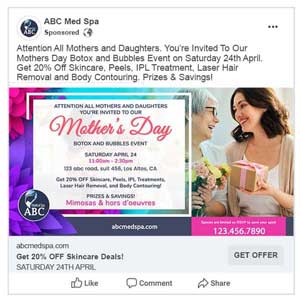
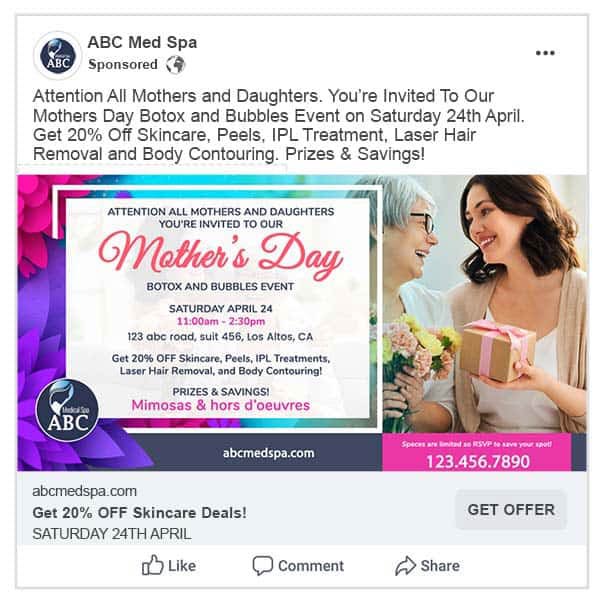
Facebook’s advertising platform allows medical and dental practices to advertise their services to a target audience. Compared to Google AdWords, the potential audience they can reach will be smaller. However, unlike Google AdWords, Facebook Ads allows users to refine their target audience further. Both Google AdWords and Facebook Ads allow medical and dental practices to target by location, such as by zip code or a radius around a fixed point. Facebook Ads enable this targeting to be refined further by targeting an audience based on gender, age, and interests. While the overall audience will ultimately be smaller, they will be much more likely to be receptive to the ad and click on it. Also note that due to restrictions on tracking by Apple, iPhone and Mac users conversion will be harder to track from any social media platform.
Some common strategies that many medical marketing experts use to maximize the effectiveness of their Facebook ads for their medical or dental practice.
Strategy 1: Content that is useful to many target audience should be promoted
Not every page of a website will be appealing to everyone who visits it. Some pages will be written for a valuable but particular audience. Other pages, however, will appeal to a larger audience and see higher site traffic. These high-volume pages should be promoted on Facebook to reach a wider audience. For medical and dental practices, FAQ pages and their most popular service pages make excellent candidates to consider for promotion on Facebook. These ads can target audiences looking for these services and want more information or have general questions about the practice. To gauge whether or not the right audience is seeing these ads, check how long people spend time on the page. If site visitors only spend a few moments on the page, the targeting needs to be adjusted.
Strategy 2: Use Facebook video ads
Videos ads are a compelling way to convey messages to potential patients. There are many different topics a video ad could cover, but often the most effective are testimonials and service summaries. For testimonials, a patient’s video describing their satisfaction with the services can go a long way to convince others to make an appointment. Of course, a practice needs to get explicit written permission to film a patient and use it for promotional purposes. The other type of video that performs well is highlighting services and explaining their benefits. While certain pages on a site would describe a service being provided, a short video is very engaging and easily consumed by a potential patient. When filming videos for ads, try to make sure they are decently produced. They do not need to be broadcast television quality, but the picture and audio should be clear, and good lighting should be in place so the viewer can see what is going on.
Strategy 3: Use Facebook lead ads
The advertising platform available for those using Facebook has many different options. However, many medical and dental practices overlook is an effective ad format: Facebook Lead Ads or FLA. These ads are designed to generate leads for a business, or in this case, patients. FLAs will push quality leads that are very motivated (or have high intent) to seek care and make an appointment. These ads are constructed to make it as easy for a potential patient to submit information by automatically populating forms with contact information from their Facebook profile. Once the information has been submitted, there is an option to allow the patient to call the clinic directly and speak with someone about their medical or dental needs. FLAs are available on Facebook and Instagram and have proven very effective.
Strategy 4: Consider re-marketing on Facebook
Re-marketing is a marketing strategy that is very effective when it comes to PPC ads. It can also engage with current and potential patients on Facebook. Assuming a site visitor allows cookies to be downloaded, medical and dental practices can spend money to have specific ads appear in social media feeds based on the pages they have previously visited. For example, suppose a site visitor reviewed information about sports physicals but did not make an appointment. In that case, they may see ads from that medical practice about sports physicals appear later in their Facebook feed. The more times a medical or dental practice has contact with a person, the more likely they will be aware of the practice and the more likely they will make an appointment.
Strategy 5: Segment target audiences
Not all ads work for an entire target audience. The more customized and personalized an ad is to someone, the more it will resonate, and the more likely they will click on that ad. Instead of having multiple ads sent to the same giant target audience, consider segmenting a target audience into groups and customizing those ads for those groups. Facebook’s ad platform makes it very easy to create groups from a target audience and serve them ads written with them in mind. Groups can be segmented by location, age, gender, mobile devices, desktop computer, interests, and more. Knowing who an ad is being sent to, where they are viewing it, and the device they are viewing it on is excellent data to act on when creating ads. It will reduce the cost of overall ad spending and increase the click-through rate if segmentation is set up correctly. For example, creating a Facebook ad about sports physicals to show to people between the ages of 30 and 40 around a school between the times of 2 pm and 3 pm can be customized to engage parents waiting to pick their kids up from school. These personalized ads will be more effective than a general ad.
Facebook also allows practices to be segmented by behavior. By analyzing what other pages they visit, the right ads can serve them when they are more motivated to take action. For example, a user may need to get their vaccinations updated before traveling overseas. If Facebook sees that they are visiting various pages of oversea landmarks and locations and is currently located in a different country, that would be a great time to show them ads regarding travel vaccinations. Practices could go the extra mile and create ads based on the places they are likely to visit. Different ads could be made for those visiting places like South America or India to boost engagement.
Strategy 6: Including an offer will increase patient engagement
Everyone likes to get extra value out of something and is drawn to the thought of getting more than what is usually available. Adding an offer to a Facebook ad is a great way to boost engagement. For example, a medical or dental practice could offer a free consultation to new patients. Potential patients are more likely to try a service if there is no financial risk or obligation. Practices can get their contact information for future marketing purposes, such as their phone number or email. Other practices, like med spas, can offer discounts on services or products for first-time customers. Be mindful that the offers in these ads need to be something valuable and tangible. If it does not value the potential patient, it will not be seen as an offer.
Strategy 7: Research your target audience
Creating ads to reach a target audience helps medical and dental practices know as much as they can about that audience. A critical thing to know is the keywords they use when searching for a practice’s services. Knowing what keywords to target in ad campaigns will have the right ad served to the right person, increasing the number of clicks it will receive. The more relevant an ad is to a person, the more likely they will engage with it. Another thing to research when it comes to Facebook Ads is to see what other interests and pages a target audience remember also engages with. If it is clear that a segment of a target audience also shares similar interests or follows the same page, ads can be customized to appear on those pages and engage with other potential patients.
Strategy 8: Spend Ad money to boost content
Unfortunately, the organic reach of Facebook’s business pages is relatively low. Some studies put the average percentage of followers of a page seeing an organic post somewhere between 1% and 5%. The chances of a post being seen by someone who does not follow a page are even lower. A practice can increase those percentages by boosting posts with ad money. They can set a budget and a target audience to have a post appear in other people’s feeds on Facebook. When promoting content, make sure it is worthwhile and engaging. Spending money to boost a post reminding people of weekend office hours probably will not get the engagement a practice is looking for. That money would be better redirected to a post featuring a blog post, quiz, offer, or other valuable and engaging content to a target audience. Finally, when boosting content, be sure to set the distance of how far out from a practice you want the promotion to run. Promoting a discount offer to someone 50 miles away may not be the best use of money, while boosting to an audience in a closer and drivable distance to a location may get better results.
Strategy 9: When writing ads for Facebook, be specific and careful with ad copy
Facebook ads are not the Wild West where anything goes. Health organizations, such as a medical or dental practice, have additional restrictions. They have to be more careful about what they promote and how their ads are put together. As a rule, Facebook does not like ads with too much text when boosting a post with a picture. Only a certain percentage of space on that picture can have text on it, and the rest of it must be an unobscured picture. Too much text in an ad will lead it to be rejected.
The ad can not make any claims that it will cure, improve, or help conditions for health organizations. The ad must state facts in a neutral tone without making promises. For example, an ad can not promote a teeth whitening treatment to make someone look better and more attractive. The ad could highlight the available type of treatment and a discount for first-time patients, and that’s it. Anything more, and the ad will be rejected. Facebook also will put restrictions on ads at other times, such as during public health emergencies. During COVID-19, practices found it challenging to promote anything related to COVID-19, such as testing or vaccines. The wording had to be very careful, and ads had to be submitted multiple times before they were up and running. Any ads selling masks or health products related to COVID-19 were banned outright. Eventually, these restrictions were eased, but medical and dental practices need to be mindful of health-related restrictions.
Strategy 10: Whenever possible, have prospects/leads submit contact information using PatientGain HIPAA compliant CRM
When current or potential patients click on a Facebook ad, they can be incredibly more effective if they get contact information from the person engaging with it. Trading an email or cell phone number for a discount or some other special offer is a good trade and will make an ad even more valuable. Those people can then be followed up with other campaigns, increasing the likelihood of making an appointment. With Facebook Ads, it is easy to add this sequence into campaigns when appropriate. Make sure that the submission of this information is in exchange for something valuable. Submitting an email address for office hours publicly available elsewhere will not get the results a practice wants.
3 Key Elements of Facebook & Advertising Marketing For Dental and Medical Practices
It is easy to be confused by how and when to use Facebook platform for medical marketing. There are 3 key areas for Facebook marketing.
No 1. Facebook Posting
Facebook posting allows you to engage with patients who like your Business Page. We have seen very good results for physicians and medical practices who provide useful information about their services. Facebook Posts are designed for engagement and it takes a significant amount of time and money to develop a healthy following using Facebook Posts for doctors.
Example of a Facebook post for a dental practice :
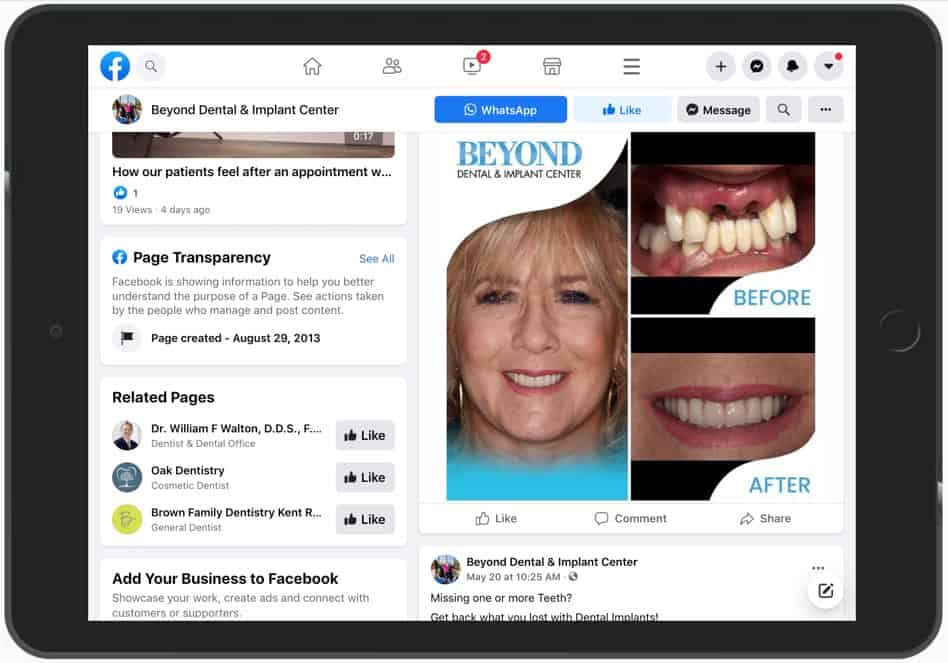
No 2. Facebook Apps
Facebook apps appear at the left column of your Facebook Business Page. They allow you to engage with patients who visit your Business Page. In a way, Facebook Business Page is evolving to be a simple website for your medical practice. So each tab or the app can be used to capture leads, book appointments, show your promotions to your patients. We have seen very good results for physicians and medical practices who provide HIPAA compliant apps on Facebook Business Page.
No 3. Facebook Advertising
Facebook Advertising costs extra, and this is how Facebook as a company makes money. Just like Google advertising, Facebook advertising can be very effective to attract new patients to your practice. We have seen very good results for physicians and medical practices who advertise their services.
Social Media Advertising Examples for Dental and Medical Practices Examples
Example of a Facebook ad for a medical spa :


Example of a Facebook ad for a dental practice :
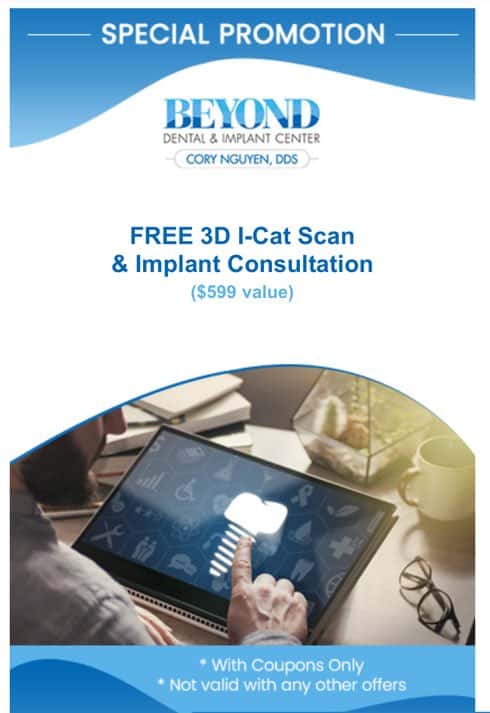
Example of a Facebook ad for an orthopedic practice :
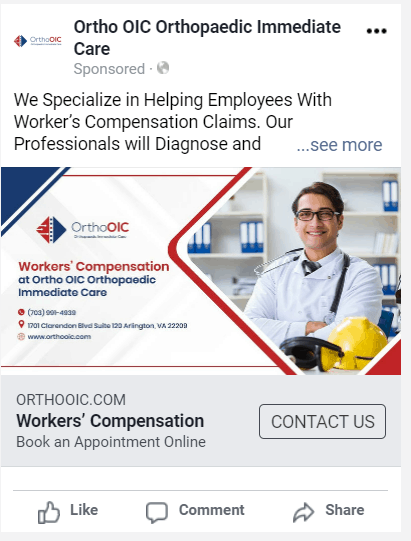
Example of a Facebook ad for a dental practice :
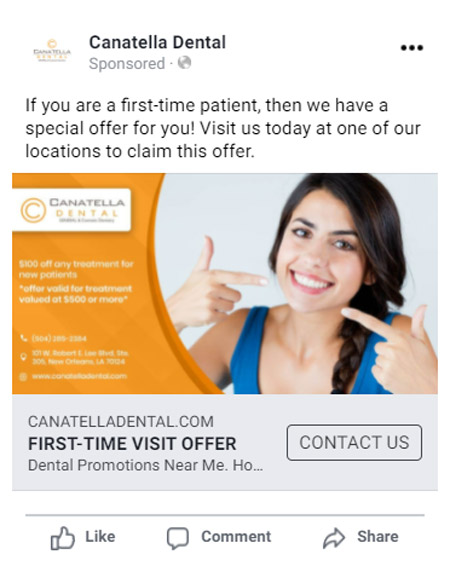
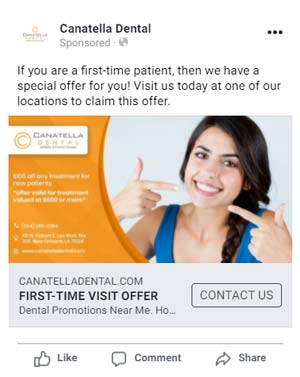
Example of a Instagram ad for a dental practice :
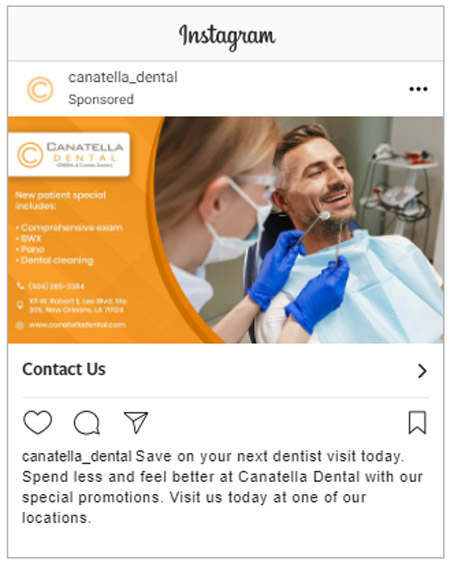
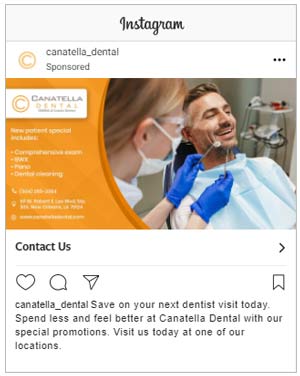
Case study : How facebook attracts a potential patient.
Stacey has had weight management problems for the last 10 years. She has made several attempts to lose weight. On the weekend, she was “socializing” with her family on Facebook. While reading Facebook story, at the of the news feed, a “sponsored” (nice way of saying Advertisement), that caught Stacey’s attention – It said “What is a Ten Pound Trim Down Program?” . Stacey clicked on it, and then on “Learn More”. It took Stacey to another page on a website – where there was information, testimonials, and an offer. When I clicked on the offer, it took me to a landing page where I put in my information to request an appointment. I then got a text message, confirmed my date and time, and I was set with an appointment. It really caught me how easy it was.
This is a very good example of how Facebook ads can help you acquire new patients.
Step 1 – Create a Facebook Business Page with Conversion Intelligence
Creating your business page on Facebook is very easy. However getting some useful results is difficult – Remember that after all Facebook is a “Social Media” so if your objective is to convert new patients from social media, you have to do more than just social interactions. First check the top image, area of the Facebook Business Page – Does it have your branding – Is the a phone number in the image – So a prospect patient or an existing patient can call you. Facebook now provides a “CALL BUTTON” make sure it is setup properly – PatientGain.com highly recommends this number should be a HIPAA Compliant Call Tracking number. The main areas of the Facebook Business Page must be filled out. So your business location, address and business hours should be accurate. As a best practice install a Call Tracking number – so you can measure how many patients are call you from Facebook Business Page. Next steps are adding additional apps Facebook Business Page.
Step 2 : Optimize Your Facebook Business Page For Facebook Search
There are millions of Facebook users who go to the top left corner of Facebook Business Page and click on “Search”. It is important for your business to show up in the search in the top area. This is just like SEO Optimization for Google Search – however this is not as complicated as optimizing for Google Search. Some of the steps you should take are related to adding complete information about your medical practice or clinic. There are over 46 settings for Facebook Business Page. Imagine how long will it take you to accurately setup a properly optimized Facebook Business Page. Get a professional to do this for you.
Step 3 – Add Your Services to Facebook Business Page
This is very important step – you should not over look this step. As you add accurate information for each of your service, add unique non-copied text for each service. Images, pricing information and any other information will help your business. Example of the services would be : If your medical clinic provides filler Injections – List the service details, pricing & images of before and after would be great.
Step 4 – Add Instant Reviews App To Facebook Business Page
For your medical practice, there are 3 most important websites on the internet. No 1 is your own website , No 2 is Google and No 3 is Facebook – As you build your “Likes” on your Facebook Business Page, you can use this traffic to acquire Positive Reviews on Google & Yelp. Each patient review with a 5-Star rating on Google increases your ability to acquire new patients and helps you retain your existing patients also. Google Reviews are still the most effective reviews for your medical clinic. Other sites are important, but much less than Google. 78 percent of your online success is still likely to come from Google. Use PatientGain’s “Facebook Instant Reviews App” to direct traffic from Facebook to your Review sites like Google Reviews and Yelp. These 2 sites are extremely effective for your Online Reputation.
Step 5 – Add Medical Service Promotions App To Facebook Business Page
Online Promotions for medical practices does not imply discounts – it means that we provide visual clickable “Promotions” so a prospect or an existing patient can “click” on your services. PatientGain.com’s software can capture the details of the click and stores the demographic information in the intelligence database. By adding this Promotions app to your Facebook Business Page, you can generate another source of leads. PatientGain’s data shows that this app is clicked on and generates more patients than any other Facebook Business Page. This app captures and stores information securely in Patient CRM which is HIPAA Compliant.
Step 6 – Advertise on Facebook
Advertising on Facebook can be very simple for most purposes. But there are two main areas that require attention to detail.
1) Demographic and targeting initially seems simple – however in order get a good ROI, you will need to experiment – Which means wasting your ad dollars.
2) Conversion is VERY TRICKY on Social Media sites. We recommend installing PatientGain.com’s Conversion Apps on the Facebook Business Page – This will allow you to capture patient data and store in a HIPAA Compliant CRM.
Step 7 – Start Posting Using Automation and Medical / Dental Content
Most of the doctors and medical marketing staff at practices do not have time to attend to daily and weekly postings. PatientGain.com’s Facebook Posting App includes content created for you. You simply need to approve the content. See more details here.
